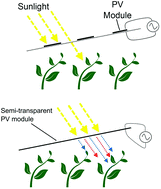Organic photovoltaic greenhouses: a unique application for semi-transparent PV?†
Abstract
Organic photovoltaics are an emerging solar power technology which embody properties such as transparency, flexibility, and rapid, roll to roll manufacture, opening the potential for unique niche applications. We report a detailed techno-economic analysis of one such application, namely the photovoltaic greenhouse, and discuss whether the unique properties of the technology can provide advantages over conventional photovoltaics. The potential for spectral selectivity through the choice of OPV materials is evaluated for the case of a photovoltaic greenhouse. The action spectrum of typical greenhouse crops is used to determine the impact on crop growth of blocking different spectral ranges from the crops. Transfer matrix optical modelling is used to assess the efficiency and spectrally resolved transparency of a variety of commercially available semi-conducting polymer materials, in addition to a non-commercial low-band-gap material with absorption outside that required for crop growth. Economic analysis suggests there could be a huge potential for OPV greenhouses if aggressive cost targets can be met. Technical analysis shows that semi-transparent OPV devices may struggle to perform better than opaque crystalline silicon with partial coverage, however, OPV devices using the low-band-gap material PMDPP3T, as well as a high efficiency mid-band-gap polymer PCDTBT, can demonstrate improved performance in comparison to opaque, flexible thin-film modules such as CIGS. These results stress the importance of developing new, highly transparent electrode and interlayer materials, along with high efficiency active layers, if the full potential of this application is going to be realised.


 Please wait while we load your content...
Please wait while we load your content...